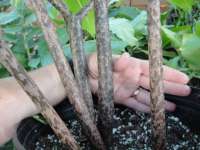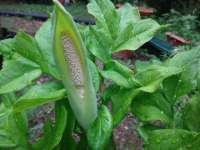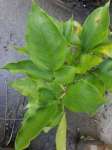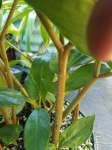 IAS on Facebook IAS on Facebook
 IAS on Instagram IAS on Instagram

|

IAS Aroid Quasi Forum
About Aroid-L
This is a continuously updated archive of the Aroid-L mailing list in a forum format - not an actual Forum. If you want to post, you will still need to register for the Aroid-L mailing list and send your postings by e-mail for moderation in the normal way.
|
Can Anyone
|
From: Susan B <honeybunny442 at yahoo.com>
on 2020.09.06 at 16:29:43(24390)



 (File Type Not Recognized: attachments/200906101701-5.png)
(File Type Not Recognized: attachments/200906101701-5.png)
Definitely looks like one of the Pseudodracontiums, as they used to be called, now moved into Amorphophallus, even though they flower at the same time leaves are up.
In 2009 these were available from a plant distribution from MOBOT:
Pseudodracontium
anomalum
66056
Pseudodracontium
fallax
79452 = H.AM.162
Colombia. Valle del Cauca.
Queremal to Anchicayá, ca. 10 km W of Queremal.1100 m 03.33.00N
076.45.00W
Pseudodracontium
harmandi
76149= H.AM.258
Thailand. Si Chang Island (Maxwell-683) (HAM 258)
Pseudodracontium
lacourii
79453 = H.AM.209
Pseudodracontium
latifolium
H.AM.167
latifolium has green petioles with green spots, harmandii has brown petioles with dark spots. I suppose you can look the others up on the IAS website. Be careful, there is an Am. harmandii, and an Am. pseudoharmandii, you want the latter.
Attached are a few photos of my pseudoharmandii, it doesn't look quite like yours.
I think the HAM accession numbers were originally from Wilbert Hetterscheid? He also used to do distributions, maybe back around 2002 or so?
Susan B
| HTML +More | |
In the pockets of the pope, the octopus is a lot of things...
On Sunday, September 6, 2020, 10:26:24 AM EDT, XYZ2 in Virginia wrote:
Hi, I’ve been able to get some more information and photos to try to obtain a positive identification of this plant. The grower acquired the plant from Alan Galloway about 15 to 20 years ago and he has been cultivating it since then. The photos attached are of the spathe, leaves, and petioles. The petioles are about 8 inches high from where they emerge from the soil to where the divided leaf forms.
Thanks for your help. I appreciate it.
Bern
_______________________________________________
Aroid-L mailing list
Aroid-L@gizmoworks.com
https://gizmoworks.com/cgi-bin/mailman/listinfo/aroid-l
------=_Part_2867431_695435099.1599409783547--
------=_Part_2867434_82572021.1599409784137
|
|
From: taylorholzer at yahoo.com
on 2020.09.06 at 19:07:50(24391)
I should have an old email from him explaining differences in the species, I will have to look.
It’s the next best thing since we unfortunately can’t ask him.
On Sep 6, 2020, at 3:06 PM, taylorholzer@yahoo.com wrote:
| HTML +More |
Would probably be best to ask Alan.
Looks like Amorphophallus pseudoharmandii to me but many that used to be in Pseudodracontium look similar.
On Sep 6, 2020, at 10:26 AM, XYZ2 in Virginia wrote:
Hi, I’ve been able to get some more information and photos to try to obtain a positive identification of this plant. The grower acquired the plant from Alan Galloway about 15 to 20 years ago and he has been cultivating it since then. The photos attached are of the spathe, leaves, and petioles. The petioles are about 8 inches high from where they emerge from the soil to where the divided leaf forms.
Thanks for your help. I appreciate it.
Bern
_______________________________________________
Aroid-L mailing list
Aroid-L@gizmoworks.com
https://gizmoworks.com/cgi-bin/mailman/listinfo/aroid-l
--Apple-Mail-403DC9DC-FB82-411A-A657-6E5A7B6B11C7--
--==============163529331572637926==
|
|
From: taylorholzer at yahoo.com
on 2020.09.06 at 19:06:30(24392)
Would probably be best to ask Alan.
Looks like Amorphophallus pseudoharmandii to me but many that used to be in Pseudodracontium look similar.
On Sep 6, 2020, at 10:26 AM, XYZ2 in Virginia wrote:
| HTML +More |
Hi, I’ve been able to get some more information and photos to try to obtain a positive identification of this plant. The grower acquired the plant from Alan Galloway about 15 to 20 years ago and he has been cultivating it since then. The photos attached are of the spathe, leaves, and petioles. The petioles are about 8 inches high from where they emerge from the soil to where the divided leaf forms.
Thanks for your help. I appreciate it.
Bern
_______________________________________________
Aroid-L mailing list
Aroid-L@gizmoworks.com
https://gizmoworks.com/cgi-bin/mailman/listinfo/aroid-l
--Apple-Mail-A06AACED-4A2D-4293-9FBF-3BF89DBF0755--
--==============C67873785138867597==
|
|
From: Lester Kallus <lester at kallus.com>
on 2020.09.07 at 18:05:16(24393)
I apologize in advance if this is a
duplicate - but some email issues on my end are still ironing
themselves out.
I’m submitting this to Aroid-L now because
there are only 70 days left before a submission deadline for the
December IAS Newsletter, Issue 42-04.
So far, I have a Table of Contents with no listings & a
green box on the mailing page reminding members to renew
membership online.
This makes for a very quick read – but some would argue that
it’s not very educational (or interesting, for that matter).
There will be an online supplement entitled “The European Aroid
Community – New Interest in the Age of Social Media” but, as I
mentioned, that will be available online only.
I urge any potential authors to consider contributing to the
printed newsletter.
Lester
| HTML +More |
--------------860FCFC3F70B8E8BD74F461B--
--=============="68480785082203834==
|
| |
Note: this is a very old post, so no reply function is available.
|
|






